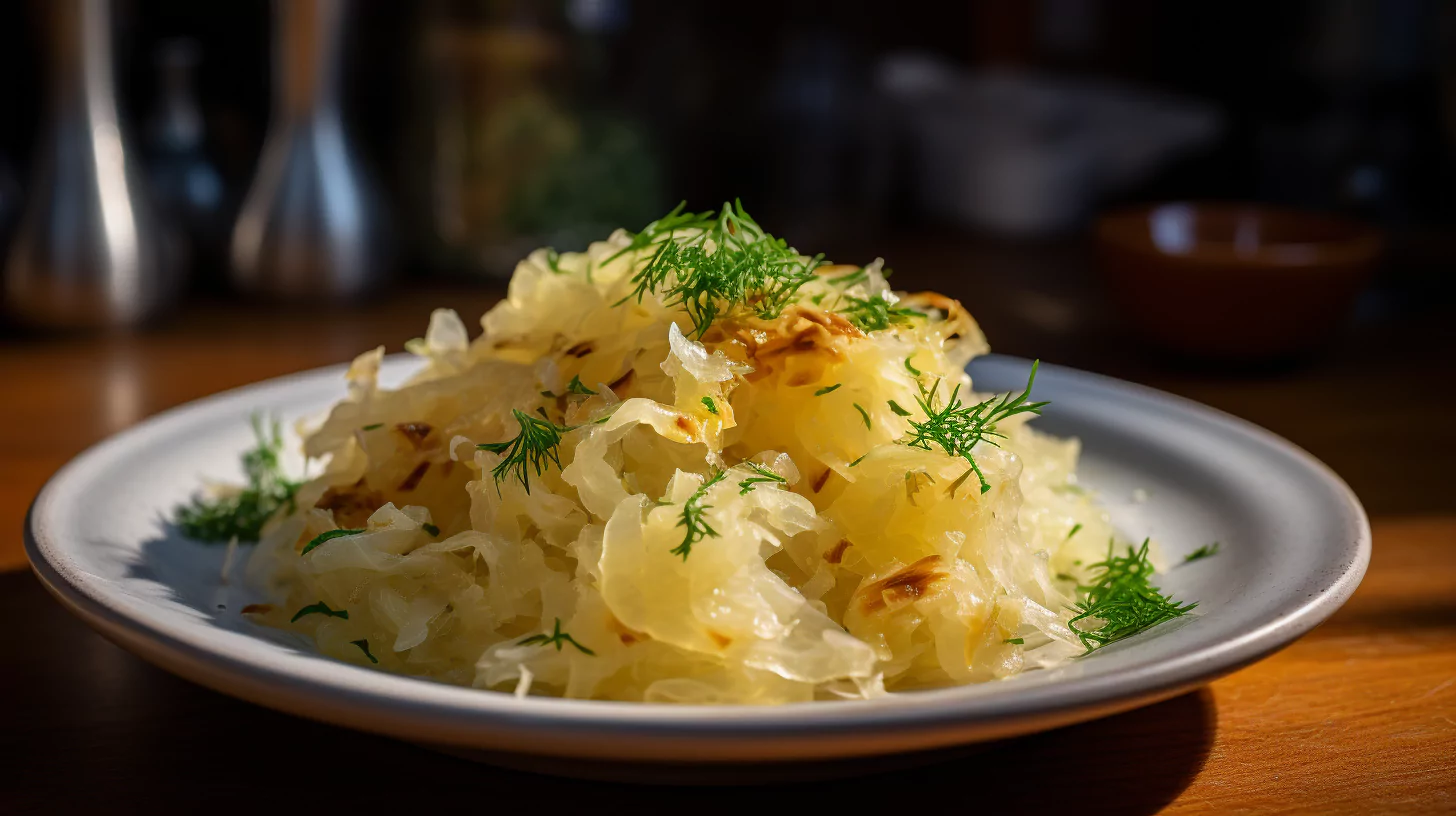Kimchi, kefir, miso, tempeh, kombucha… They’re tangy, they’re sour, they’re sharp in flavor, and they’re all the rage in wellness circles. It turns out that these fermented foods for gut health, packed with probiotics, are game-changers.
No more bloated belly. No more unexpected cramps. And definitely, no more of that frantic sprint to the nearest restroom. Because fermented foods may just be the missing puzzle piece in your digestive wellness routine.
8 best fermented foods for gut health
Fermented superfoods pack a flavorful punch while working wonders for your digestive health. In fact, Stanford University research shows that adding these foods to your diet might boost your gut’s microbiome diversity and even dial down inflammation.
So that begs the question: What fermented foods are good for gut health? Hilary Keiser, a biochemist at Viome, where cutting-edge technology is employed to assess and understand your gut microbiome, offers a rundown on a list of fermented foods for gut health:
- Sauerkraut and kimchi. Salt-wielding experts actively ferment cabbage to make these tangy delights.
- Yogurt. This go-to snack gets its start when you add friendly bacteria to milk or milk alternatives, setting off the fermentation.
- Kefir. This tangy drink comes to life when a special mix of yeast and bacteria gets busy fermenting milk, juice, or coconut water.
- Kombucha. This bubbly tea earns its fizz from a unique team of yeast and bacteria, known as a SCOBY (symbiotic culture of bacteria and yeast), working together to ferment it.
- Miso. In the making of this traditional Japanese spice, soybeans meet salt and koji fungus. You can add grains, which bring out a rich, savory taste.
- Tempeh. This hearty food takes shape when soybeans, or sometimes other beans, are fermented with a friendly fungus known as Rhizopus oligosporus.
- Pickles. Crunchy and tangy, these are cucumbers that have been left to ferment in a simple mix of water, salt, and spices.
- Cheese. It starts with milk, but with the help of lactic acid bacteria and enzymes, it becomes cheese.
Each of these foods brings its own special zest to the table. And eating them is not just a treat for your taste buds; it also helps restore gut health as well as maintain it.
8 low sugar fermented foods for gut health
Maintaining a low sugar intake doesn’t mean you have to miss out on the benefits of fermented foods. Here’s a list of eight options, as per Hilary’s recommendations, that are naturally low-sugar and provide the probiotic punch your gut needs:
- Sauerkraut and kimchi. Their natural fermentation process keeps sugar content low.
- Plain, unsweetened yogurt. Without added sugar, it’s a gut-friendly choice that keeps you feeling good.
- Unsweetened kefir. It’s got all the benefits of yogurt but with a unique, tangy twist.
- Miso. It’s a fermented paste that boosts your dishes with a rich, savory kick.
- Tempeh. This soy-based food is not just filling but also has minimal sugar, making it a versatile ingredient in healthy diets.
- Pickles. Opt for the ones that aren’t made with added sugar.
- Cheese. It’s generally low in sugar, but just keep an eye out for added flavors that might up the sugar content.
- Natto. This traditional Japanese food is made from fermented soybeans and is known for its strong flavor and sticky texture.
You can also DIY your own fermented foods to help improve gut health. As Hilary explains, “You can make any sugary fermented foods (like kombucha) low in sugar content by adding less sugar and fermenting longer so that the microbes consume more of the sugars.”

3 easy and delicious fermented food recipes for better gut health
Looking to weave some culinary magic into your gut health diet? According to Hilary, these three fermented foods for gut health recipes are as tasty as they are beneficial.
1. Gut-Friendly Golden Sauerkraut
Natural fermentation meets the anti-inflammatory prowess of turmeric and the digestive comfort of cumin seeds in this sauerkraut. It makes the perfect topper for everything from salads to curries.
Ingredients
1 head organic green cabbage, finely sliced or shredded (reserve the outer cabbage leaf)
Fine sea salt
1-inch knob of turmeric, peeled and grated
1 tsp cumin seeds
Instructions
- Add cabbage and cumin seeds to a bowl. Weigh the mixture in grams using a kitchen scale, being careful not to weigh the bowl. Multiply the weight of the cabbage in grams by .02. This is the amount of salt you will need, in grams.
- Add the salt. Mix and massage the cabbage well with your hands.
- Add the turmeric and mix using a spoon (turmeric will stain your hands and fingernails).
- Allow the mixture to sit for several hours (about 2-6 hours) while the moisture draws out. Stir occasionally.
- Stir the sauerkraut again, and then place it in a large glass jar. Pack it down into the jar well using a sauerkraut tamper, your hands, or the end of a wide spoon. Pack well so that the liquid (aka brine) covers the contents. If the brine does not cover the contents, make an additional 2% brine (1 ¼ teaspoons salt to 1 cup water) and add enough to the jar to cover all the cabbage.
- Fold the reserved outer leaf of the cabbage and place it on top of the sauerkraut to help keep it below the brine. The salt in the brine prevents oxidation and the growth of molds.
- Place a fermentation weight, small jar, or ziplock bag filled with water on top of the cabbage leaf to help keep the mixture pressed down.
- Cover loosely with a lid and place in a warm place (preferably around 68-75F) for about 3-5 days. “Burp” the jar daily to release any pressure build-up.
- The fermentation will occur faster if the jar is in a warmer place than in a colder place. When you start seeing some bubbles, this means it’s getting close. You can start tasting the sauerkraut around day 3. Once it has reached your desired level of sour flavor and softness, place the jar in the fridge to stop or slow the fermentation.
- Sauerkraut stores well in the fridge for up to 6 months. Continue to burp the jar occasionally to release any pressure build-up.
Note
- Sauerkraut is typically made using a 1.5–3% brine. You may use more or less salt in step 1, as long as it is within 1.5–3%.
- Using organic cabbage is critical for sauerkraut. Some pesticides can kill the microbes naturally present in the cabbage that promote fermentation.
- If you’re using a particularly large head of cabbage, more turmeric and cumin seeds can be added without affecting the fermentation process.
2. Zesty Probiotic Carrot Crunches
This recipe is simple and zesty, making it a deliciously tangy and fun-to-eat treat. Add these carrot sticks to your morning routine for an optional zing to your gut-healthy breakfast.
Ingredients
Glass jar
About 1.5 lbs carrots
1 jalapeño
2 cups filtered water
1 ½ tsp sea salt
Instructions
- Dissolve the sea salt in filtered water, then set it aside for later use.
- Peel the carrots, trim off the ends, and slice them into stick shapes.
- Prepare the jalapeño by trimming it and slicing it into round discs.
- Lay the jar on its side and place half of the jalapeño slices inside.
- Fill the jar with carrot sticks until it’s about halfway full.
- Add the remaining jalapeño slices on top of the carrots.
- Continue to add carrot sticks, packing them tightly until no more can fit.
- Stand the jar upright and pour in the saltwater solution until everything is submerged.
- Seal the jar with a lid and leave it on your countertop for 2 to 3 days.
- Watch for bubbles and slight cloudiness in the water, signaling it’s time to move the jar to your refrigerator door.
- Allow the jar to sit in the fridge for 10 to 14 days to further ferment and develop flavors.
- Once you’re ready to enjoy, open and store the jar on a refrigerator shelf to slow down any further fermentation.
3. Savory Noir Bean Tempeh Delight
Four ingredients—that’s all you need to craft your own soy-free version of tempeh. It’s a nutty, perfectly textured alternative that you can add to any soy-free dish.
Ingredients
1 cup dry black beans
3 cups water
2 tsp white rice vinegar
½ tsp tempeh starter
Instructions
Instant Pot Method:
- Rinse the black beans with cold water and let them drain.
- Place the beans in the Instant Pot container and pour in 3 cups of water.
- Seal the lid, set the valve to “Seal,” and select manual pressure cook for 30 minutes.
- After cooking, allow the pressure to release naturally for 20 minutes before opening the lid and draining the beans.
Stovetop Method:
- Soak the black beans in cold water overnight or for a minimum of 8 hours.
- Drain the beans and transfer them to a large pot, then cover them with about 5 cups of water.
- Bring the water to a boil, let it bubble for 10 minutes, then reduce the heat, cover, and simmer for roughly 50 minutes. Check the beans occasionally to ensure proper cooking.
- Once done, drain the beans.
Preparation:
- Lay a clean kitchen towel on a baking sheet and spread the beans out to dry for 20–25 minutes.
- In a bowl, toss the beans with white rice vinegar until they are evenly coated.
- Sprinkle the tempeh starter over the beans, stirring until it’s fully integrated.
- Poke small holes at 1-inch intervals into a small freezer bag using a chopstick or skewer.
- Fill the bag with beans, pressing them down to remove air and ensuring they’re tightly packed, then fold over the excess bag.
Fermentation:
- Clean the Instant Pot liner if used previously, fill it with 1 cup of water, and place the steam rack inside.
- Set the filled bag on the rack and secure the lid.
- Press the Yogurt button three times until it’s on “Less” mode, then set it for a 24-hour fermentation.
- After 24 hours, the bag should feel warm. If not, continue in yogurt mode for another 10 hours.
- Let the beans incubate for an additional 24 hours with the Instant Pot lid on.
Finishing:
- After 48 hours, the beans should have transformed into a firm, cohesive loaf of tempeh.
- Store your fresh tempeh in the refrigerator for up to 7 days and use it as you would traditional soy tempeh—in stir-fries, marinated, fried, or baked.
Shedding light on common queries about fermented foods for gut health
Navigating the world of fermented foods can bring up a lot of questions. Turning to Hilary and her expertise, here are some answers to help demystify the process and get you on your way to a happier gut.
Why are fermented foods good for gut health?
The fermentation process enriches foods with probiotics, prebiotics, and bioactive components. They can also create substances like short-chain fatty acids, vitamins, and antioxidants.
This is gold for your gut: it can modify the gut microbiota, reduce inflammation, and influence immune activation. As a result, it can potentially impact mechanisms associated with depression and anxiety.
When to eat fermented foods for gut health
The truth is, there’s no set schedule. According to Hilary, fermented foods “can be eaten any time of the day, with or without other foods.”
Whether it’s breakfast or a midnight snack, you can consume these foods whenever you want.
How often should you eat fermented foods for gut health?
Fermented foods can and should be eaten daily; however, there are some caveats:
- Focus on foods that are low in sugar and salt if you have hypertension or high salt stress.
- Some of these foods may also be high in FODMAPS (fermentable oligosaccharides, disaccharides, monosaccharides, and polyols), which are compounds that should be avoided for people who have IBS or other digestive problems.
- These foods are also not recommended for people who have histamine sensitivity or intolerance.
With all that in mind, if you’re not used to eating fermented foods, start with eating a small amount per day and increase the amount as tolerated.
Make a change, create an impact
Taking charge of your gut health is an act of self-care, for sure. It’s also a revolutionary step toward a vibrant life. And getting familiar with what fermented foods for gut health can be incorporated into your day-to-day diet can make a world of difference.
So when you’re ready to take your health and knowledge to the next level, there’s the Mindvalley Viome Certified Nutrition Coach program waiting for you. You’ll learn from Naveen Jain, the founder of Viome, and his team to discover the what, why, and how to improve and maintain nutritional health.
What’s more, the program will also help you empower others to achieve their health goals, too. So step into this transformative experience and inspire greatness in everyone around you.








